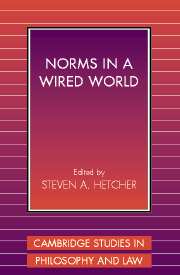Book contents
- Frontmatter
- Contents
- Acknowledgments
- Introduction
- PART I THE PATTERN CONCEPTION OF NORMS
- PART II NEGLIGENT NORMS
- 6 The Traditional Rule of Custom
- 7 The Evidentiary Rule of Custom
- 8 A World of Dangerous Norms and Customs
- 9 Regulating the Rule of Custom to Create Safe Social Norms
- 10 Juror Norms and the Reasonable Person Standard
- 11 Rejection of the Dominant Paradigm of Negligence
- PART III CYBERSPACE PRIVACY NORMS
- Conclusion
- Notes
- Index
9 - Regulating the Rule of Custom to Create Safe Social Norms
Published online by Cambridge University Press: 05 June 2012
- Frontmatter
- Contents
- Acknowledgments
- Introduction
- PART I THE PATTERN CONCEPTION OF NORMS
- PART II NEGLIGENT NORMS
- 6 The Traditional Rule of Custom
- 7 The Evidentiary Rule of Custom
- 8 A World of Dangerous Norms and Customs
- 9 Regulating the Rule of Custom to Create Safe Social Norms
- 10 Juror Norms and the Reasonable Person Standard
- 11 Rejection of the Dominant Paradigm of Negligence
- PART III CYBERSPACE PRIVACY NORMS
- Conclusion
- Notes
- Index
Summary
What usually is done may be evidence of what ought to be done, but what ought to be done is fixed by a standard of reasonable prudence, whether it usually is complied with or not.
Oliver Wendell HolmesIntroduction
In Chapter Seven, we saw that while courts nominally consider the evidentiary rule as the proper rule of custom in negligence cases, their actual treatment of customs is more complex. Courts sometimes give customs greater deference (by means of the per se rule) and other times give custom no deference (by means of the no-priority rule). The analysis in Chapter Eight demonstrated that each of the three types of rational custom has distinctive welfare-enhancing capabilities. Factors – such as whether the incidence of injury falls on conformers or third parties, whether these groups are close-knit, whether the conformer has superior epistemic warrant, whether the Kaldor-Hicks Test favors conformers, and whether an optimizing alternative practice is available – matter differentially depending on the type of custom at issue.
In this chapter, I will argue that in order to account adequately for the structured complexity of the relevant social phenomena, it will be necessary for courts to implement a more fine-grained rational actor account than is suggested by those game-theoretic accounts that focus on the Prisoner's Dilemma or collective action problem. In terms of the general analysis, thirty-seven distinct modalities of rational custom will be identified. In particular, the tripartite model of rational custom will be used to explicate the role of custom in the leading cases of Behymer and Hooper.
- Type
- Chapter
- Information
- Norms in a Wired World , pp. 198 - 214Publisher: Cambridge University PressPrint publication year: 2004



